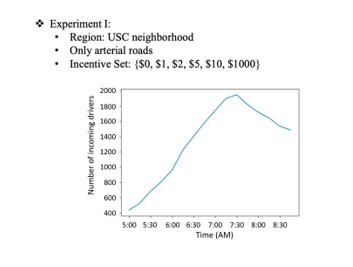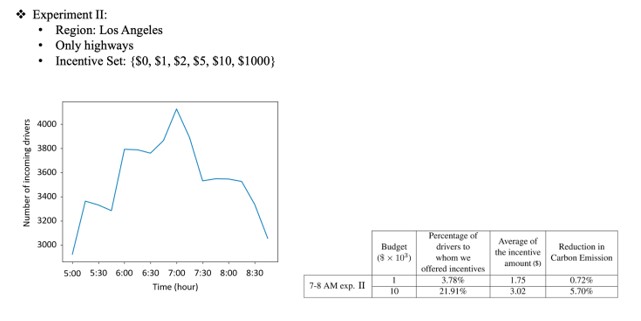News | METRANS, PSR, NCST, USC ITE host Razaviyayn and Ghafelebashi for Congestion Reduction via Personalized Incentives Seminar
Stop the VideoNews

METRANS, PSR, NCST, USC ITE host Razaviyayn and Ghafelebashi for Congestion Reduction via Personalized Incentives Seminar
Tuesday, March 30, 2021
by Hayley Rundle, USC, Masters of Urban Planning 2022
On March 11, METRANS and the Pacific Southwest University Transportation Center (PSR), along with special partners the National Center for Sustainable Transportation (NCST) and USC Institute of Transportation Engineer (ITE), hosted their second research webinar of Spring 2021. Titled “Congestion Reduction via Personalized Incentives,” this event showcased the research of Dr. Meisam Razaviyayn, Assistant Professor of Industrial and Systems Engineering with courtesy appointments at the Electrical Engineering and Computer Science department at USC, and Ali Ghafelebashi, third-year Ph.D. student studying Industrial Engineering at USC. “I have been following this thread of research for a while,” shared METRANS and PSR Director Dr. Genevieve Giuliano, “and it is one of the most promising areas [of research] using technology and advanced modeling techniques to figure out how to do a better job of matching riders and drivers.”
-0.png)
The event was co-hosted by USC Institute of Transportation Engineers (ITE), a student group of engineers, planners, and thinkers who aim to reimagine transportation systems, and in collaboration with the National Center for Sustainable Transportation at UC Davis, in which METRANS is a partner. The research presented at this seminar has also contributed to NCST’s research. “Congestion reduction is extremely important for transportation engineering and the impacts of VMT, and this research aligns well with ITE’s mission,” commented James Huang, ITE member and second-year Industrial Engineering student at USC.
The webinar was attended by transportation professionals and enthusiasts from across the nation, including public and private sector transportation professionals, faculty, researchers, and students at all levels of study. The session began with a formal presentation with a discussion of the audience’s questions throughout the presentation.
Ghafelebashi began the presentation by describing the motivation and background of this research project, pointing out that the cost of traffic congestion in the United States in 2019 was $88 billion which has consequently worsened air quality. Ghafelebashi also discussed solutions to solve traffic congestion, including adding more capacity, using transportation system management and operation (TSM), and using demand management. Ultimately, the researchers decided on utilizing a rewarding policy that would offer a positive incentive following the success of three projects in the Netherland and the CAPRI project which motivated drivers to avoid driving during rush hour or walk/bike in exchange for a monetary incentive.
Ghafelebashi continues by describing the incentive offering process as personalized and dynamic to reflect different individuals, different times, and different routes with the overall goal of avoiding creating new congestion. The incentivizing process is high-level and detailed, occurring in multiple steps. First, the driver shares their traffic data and preferences including origin and destination to the central planner. The user data and traffic data are then received, and then based upon traffic predictions and possible alternative routes, incentives are offered to individual drivers. The driver then receives the route options and incentives and makes a decision.

Diagram representing the personalized and dynamic incentive offering process.
Ghafelebashi then moved into the modeling behind the research project, reiterating that the goals and objectives of the research are to minimize incentivizing cost, maximize a utility of the drivers’ travel time, and minimize carbon emission footprint. The models and network construction were constructed using data from the Archive Data System Management (ADMS), a collaboration with LA Metro and USC that collects traffic data from sensors located at highways and arterials throughout Los Angeles. ADMS offers real time traffic data with highway data recorded every 30 seconds and arterial road data recorded every 1 minute.
A particularly exciting portion of the presentation was when Ghafelebashi presented the numerical experiments of the research. The first numerical experiment focused on a small region around the USC neighborhood that only looked at traveling by arterial roads. The experiment yielded that when the incentive was $100, this resulted in a 4.33% reduction in carbon emissions. When the incentive was $10,000, this resulted in a 17.79% reduction in carbon emissions. These results demonstrate that most people accept incentives when the incentive is higher. The second numerical experiment focused on a large region covering Los Angeles, looking at traveling by highways only. When the incentive was $100, this resulted in a 0.72% reduction of carbon emissions. Finally, when the incentive was $10,000, this resulted in a 5.7% reduction of carbon emissions.


Results from the numerical experiment focused on the small region when incentives were offered.

Results from the numerical experiment focused on the large region when incentives were offered.
The webinar wrapped up with several conclusions regarding personalized incentives and traffic congestion: offering personalized incentives to drivers to reduce congestion is successful, efficient algorithms are needed to solve the problem in large-scale, and utilizing the computation power of individuals’ smartphones can be done by a distributed algorithm. “I thought the webinar was interesting because the costs of congestion are rapidly increasing,” commented Micha Kempe, USC alumni, and former Transportation Demand Management Coordinator at USC Transportation, “and it is important to utilize new routing technologies.”
We encourage you to follow this research team’s ongoing work, now considering different travel modes, such as transit, carpooling, and biking, in their modeling options and utilizing preference learning to learn the drivers’ acceptance probability.
If you would like to watch the full video of the event or event highlights or access the presentation slides, please click here.
About the Author:
Hayley Rundle is a first-year Master of Urban Planning student at the USC Price School of Public Policy, concentrating in Mobility and Transportation Planning. Hayley is interested in sustainable transportation planning to improve environmental quality, equity, and mobility for all. Hayley serves as the team leader for the METRANS Industry Engagement and contributes to the Student Research Team, summarizing cutting-edge transportation research projects and findings for the METRANS Fast Facts for Students series.
News Archive
- December (1)
- November (6)
- October (4)
- September (2)
- August (3)
- July (4)
- June (3)
- May (7)
- April (8)
- March (11)
- February (8)
- January (7)
- December (7)
- November (8)
- October (11)
- September (11)
- August (4)
- July (10)
- June (9)
- May (2)
- April (12)
- March (8)
- February (7)
- January (11)
- December (11)
- November (5)
- October (16)
- September (7)
- August (5)
- July (13)
- June (5)
- May (5)
- April (7)
- March (5)
- February (3)
- January (4)
- December (4)
- November (5)
- October (5)
- September (4)
- August (4)
- July (6)
- June (8)
- May (4)
- April (6)
- March (6)
- February (7)
- January (7)
- December (8)
- November (8)
- October (8)
- September (15)
- August (5)
- July (6)
- June (7)
- May (5)
- April (8)
- March (7)
- February (10)
- January (12)















